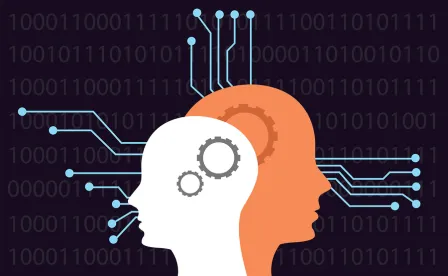A key question surrounding patents for artificial intelligence (AI) related technologies is can an AI agent (as in, not a human) be considered an inventor to a patent application. Last week, in a highly publicized case, the United States Patent & Trademark Office (USPTO) answered with a resounding “no” to an AI agent named “Device for Autonomous Bootstrapping of Unified Sentience” (“DABUS”) that “autonomously generated” the invention in question. The decision explained that an AI agent cannot meet certain statutory definitions for an inventor or the jurisprudential tests for determining inventorship.
In the USPTO’s view, the language of the Patent Act suggests an inventor must be a natural person because it uses terms such as “whoever,” “himself or herself,” and “individual” when describing an inventor. The Act also describes actions that can only be performed by a human being, for example, by directing an inventor to “execute an oath or declaration.” The decision further cites case law defining the contours of inventorship, which turns on the question of “conception.” Generally, the legal tests for conception require a person to conceive of and contribute to the inventive subject matter in the claims. According to the USPTO, these tests contemplate conception in the “human mind” and therefore only natural persons can satisfy the requirements for inventorship.
The DABUS Application
The applicant, Stephen Thaler, in conjunction with the Artificial Inventor Project, filed a patent application for Devices and Methods for Attracting Enhanced Attention in various jurisdictions around the world, including the United States. The application was highly publicized because it listed DABUS, an AI agent, as the sole inventor.
Unlike the inventors for every other patent application filed at the USPTO, DABUS is not a human being. Rather, it is an AI agent created by a team of researchers designed as a “creativity machine” to mimic the creative problem solving skills of a natural person. Thaler reasoned that since the invention disclosed in the patent application was generated entirely by DABUS, without any human involvement, DABUS was owed inventorship credit. Thaler thus listed DABUS as the sole inventor accordingly in the patent application’s filing documentation.
The application, however, was objected to at the pre-examination phase when compliance with various formality requirements is evaluated. Specifically, the USPTO issued a Notice to File Missing Parts rejecting the application as incomplete, stating that the documentation failed to identify an inventor as required. Thaler petitioned for an administrative review of the alleged deficiency, arguing that inventorship is not limited to natural persons and DABUS was properly identified as the inventor. The Office of Petitions disagreed, finding that an AI agent cannot be an inventor under US law, thus confirming the USPTO’s view on the overarching question—only natural persons can be inventors.
The Decision
The USPTO’s decision was based primarily on its interpretation of certain portions of the Patent Act (35 U.S.C. § 100 et seq.) pertaining to who is an “inventor” and what acts are performed by an inventor. According to the USPTO, these sections of the Patent Act indicate that an inventor must be a natural person:
-
35 U.S.C. § 100(f), (g) each define an “inventor” as an “individual.”
-
35 U.S.C. § 101 provides that “[w]hoever invents or discovers . . . may obtain a patent.”
-
35 U.S.C. § 115(a) requires “each individual who is the inventor” to execute an oath or declaration.
-
35 U.S.C. § 115(b) requires the oath or declaration to “contain statements that . . . such individual believes himself or herself to be the original inventor.”
-
35 U.S.C. § 115(h)(1) permits “[a]ny person making a statement” in an oath or declaration to withdraw, replace, or otherwise correct the statement.
In the USPTO’s view, these sections, individually and in combination, suggest that an inventor is contemplated statutorily as a natural person. Consequently, the decision on Thaler’s petition observed “interpreting ‘inventor’ broadly to encompass machines would contradict the plain reading of the patent statutes that refer to persons and individuals.”
The decision also cites several Federal Circuit cases to support its interpretation, asserting that the court’s view is that “the patent laws require that an inventor be a natural person.” In Univ. of Utah v. Max-Planck-Gesellschaftzur Forderung der Wissenschaften E.V., the Federal Circuit held that a state cannot be an inventor. Furthermore, in Beech Aircraft Corp. v. EDO Corp., the court distinguished “inventorship” from corporate “ownership,” and expressly noted that “only natural persons can be ‘inventors.’” In both cases, the Federal Circuit visited the notion of “conception” as the “touchstone” test for inventorship, which has been described as a “mental act” and “the completion of the mental part of invention” for roughly a century. Specifically, conception “is the formation in the mind of the inventor, of a definite and permanent idea of the complete and operative invention.” In the USPTO’s view, even though the cases cited in its decision “are in the context of states and corporations,” they still frame conception and inventorship as a result of human thought and necessarily require an inventor to be a natural person. A machine, such as DABUS, therefore cannot meet the requirements for inventorship.
This decision effectively precludes AI agents from being listed as inventors in the US. Going forward, it will serve as administrative guidance to USPTO staff who evaluate whether applications are filed with all required documentation. Unless and until a Federal court holds that an AI agent can meet the statutory requirements to be an “inventor” or Congress legislatively redefines the definition of “inventor” to include an AI agent, only natural persons are eligible to be inventors. But this result is unlikely to change for the foreseeable future. Except for a handful of specialized advocacy groups and a few academics, the stakeholder community has little appetite to change the law.
International Jurisdictions
International patent offices are reviewing whether an AI agent should be eligible for inventorship, with the DABUS application as the first example. Several of the most popular patent offices have already concluded their legal frameworks will not recognize AI inventors. Specifically, the DABUS application was filed in multiple international patent offices, including the United Kingdom, Europe, Israel, and as a Patent Cooperation Treaty (PCT) international application at the World Intellectual Property Organization (WIPO). Thus far, the European Patent Office (EPO) and the UK Intellectual Property Office (UKIPO) have refused the DABUS application on the grounds that an AI agent cannot be an inventor. It is likely that other patent offices will follow the EPO, UKIPO, and USPTO. Moreover, many jurisdictions appear disinterested in changing their law to recognize AI agents as inventors.
Inventor Considerations
For the foreseeable future, all patent applications should list only human inventors. Even if an inventor believes an invention was fundamentally conceived by an AI agent, there is likely at least one aspect of the invention that can be attributed to a human inventor.
The threshold question is whether the human truly did nothing to conceive of the solution. Although an AI agent arrived at the particular solution, a human likely contributed to the conception in some fashion. Some examples of human involvement might include:
-
inputting certain operational constraints or configurations to instruct the AI agent on its specialized operations;
-
posing the problem to the AI agent through human operation or configuration;
-
selecting and inputting specialized training data; and
-
creating some downstream operation or function that benefits from the AI-generated solution.
The current state of AI technology has not yet reached general intelligence. It is thus highly likely that a human was involved in the conception or in the building of underlying technological features empowering an AI agent. Consequently, a human is also likely an inventor of the AI agent’s novel training or deployment algorithms or any novel downstream system operations enabled by the AI agent’s outputs. In filing patent applications related to the technology, the human that participated in the design of such an AI agent should thus be listed as the inventor.




 />i
/>i

